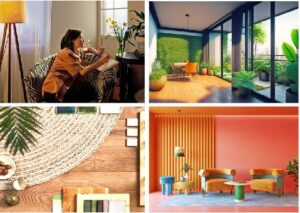This ancient Indian architectural and design system is witnessing a revival as both modern designers and homeowners aspire to infuse a contemporary perspective into their interiors, harmonizing tradition with modernity.
A Design Reawakening
The resurgence of Vastu Shastra in modern interior design is not merely a trend, it is a design reawakening. This ancient practice, dating back thousands of years, emphasizes the harmonious alignment of spaces with natural forces and cosmic energies. In today’s fast-paced urban environments, the quest for balance and tranquility within the home has fueled a renewed interest in Vastu principles. Fellow designers in Indian metropolises are also increasingly recognizing the potential of Vastu principles to bring a sense of harmony and serenity to contemporary living spaces. This fusion of tradition and modernity is reshaping the way interiors are conceived and executed.
Balancing Energies & Spatial Planning
At the heart of Vastu Shastra lies the concept of balancing the five elements: earth, water, fire, air, and space. This aspect is seen to be incorporated in interior spaces through natural materials, such as wood, stone, and metals, into their designs. These elements not only enhance the aesthetics but also create a soothing and balanced atmosphere within the home. Vastu Shastra places great emphasis on the arrangement of spaces and the flow of energy within a structure. One today reimagines room layouts to optimize the flow of positive energy or “prana.” For example, the living room, a central gathering space, is often designed to allow the free movement of energy, promoting social interaction and harmony. Vastu Shastra divides spaces into various zones, each associated with specific activities and energies. Designers are leveraging this concept to create functional and harmonious spaces within the home. The puja room, for instance, is often located in the northeast corner of the house, aligning with spiritual and positive energies.
Harmonizing Spaces With Colours, Lighting, Furniture, and Decor
In Vastu Shastra, colors are associated with specific elements and energies. Designers are carefully selecting color palettes that align with Vastu principles. For instance, earthy tones are favored in living areas to create a grounded and peaceful environment, while vibrant hues are reserved for spaces like the dining room to stimulate energy and appetite. Lighting plays a crucial role in Vastu-compliant design. The positioning of windows and the use of natural light are optimized to invite positive energy into the home. Additionally, designers are incorporating soft and ambient lighting to create a serene ambiance. Furniture placement is another aspect where Vastu principles come into play. Beds, for example, are positioned to ensure restful sleep and a sense of security. Decor elements like mirrors are strategically placed to enhance the flow of energy.
The Art of Nature Integration
Bringing the outdoors inside is a key tenet of Vastu design. Urban homeowners are increasingly incorporating indoor plants and greenery to connect with nature and purify the air. The use of natural materials like bamboo and jute in decor items and furnishings is also on the rise.
A Fresh Perspective on Materials
Vastu-compliant design places importance on the quality and source of materials. Designers are opting for eco-friendly and sustainable materials, reflecting a growing awareness of environmental consciousness. This shift is not only in line with Vastu principles but also resonates with modern design sensibilities.
The Result is A Space Where Serenity Finds Its Voice
In the hustle and bustle of Indian metropolises, modern interior design influenced by Vastu Shastra offers a unique and fresh perspective. It’s not just about aesthetics; it’s about creating spaces that resonate with a sense of tranquility and positive energy.
As interior designers, we persist in unraveling the harmonious interplay of Vastu principles and contemporary design. Meanwhile, homeowners in bustling Indian metropolises have unveiled the profound influence of balanced interiors on their daily lives. This reawakening isn’t confined to aesthetics alone; it fosters a deep connection with the rich tapestry of Indian heritage and wisdom. The sway of Vastu Shastra on modern interior design transcends fleeting trends—it embarks on an everlasting odyssey towards serenity through design.
The author is a Co- Founder and Chief Officer of Culture and Startergy at The KariGhars














